Update 3/9/2012: OCZ Z-Drive R4 Enterprise Review
The OCZ Z-Drive R4 was announced in early August as an update to OCZ's line of enterprise PCIe SSDs. The Z-Drive R4 works the same way as prior Z-Drives, there are up to eight SandForce SF-2282 powered SSDs with SLC or MLC NAND on a PCI Express board that are connected via hardware and software to deliver ultra-high performance in server and high-performance computing environments. In terms of performance numbers, this translates to maximum read speeds of 2,800 MB/s and writes of 2,800 MB/s with 4KB random write IOPS of 440,000.
In the increasingly competitive enterprise PCIe SSD space speed is the highlight, but other major factors come into play as well. OCZ has a few key advantages that out of the gate set the Z-Drive R4 aside from other solutions. The most obvious is price. We recently reviewed the Fusion-io ioDrive Duo, which is also on our charts below. While a great performing drive, the price per GB is more than $20, where OCZ's guidance is a third of that at $7/GB.
The Z-Drive R4 is also bootable, a nice touch considering its proposed use as a main drive in server systems; many PCIe SSD solutions are not bootable. OCZ is also offering a tremendous amount of flexibility with the drive, there are both full height and half height options, with the full height R4 available in capacities of 800GB, 1.6TB and 3.2TB, while leveraging eight SandForce controllers. The half height R4 is available in 300GB, 600GB and 1.2TB capacities, uses four SandForce controllers and is largely designed for use in 1U servers.
On the software side, OCZ has a good deal of secret sauce in play to not only drive performance of the SSD but to reduce overhead, like CPU usage and power consumption as well. OCZ claims their SuperScale storage accelerator reduces host CPU load compared to competing PCIe offerings. This also allows a more optimized data path, which has the side benefit of increasing storage performance. The Z-Drive R4 also leverages an efficient power management system that requires less cooling (90 vs 300 LFM) and less power. The Z-Drive works within the 26W power limits of PCIe, even at peak performance levels, while some competing drives need additional power or write speeds are throttled.
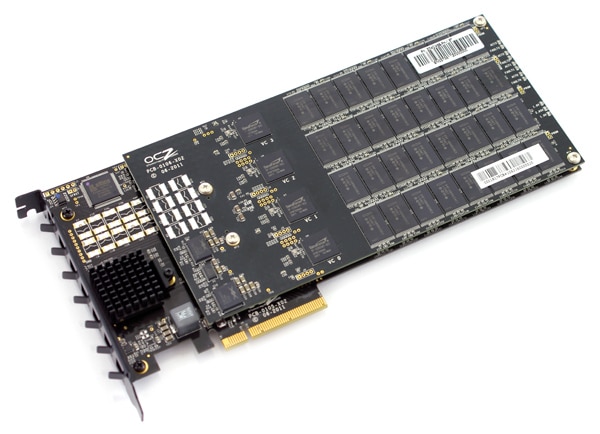
RM88 (Full-Height) Specifications:
- Available in 800GB, 1.6TB, and 3.2TB configurations
- PCI Express Gen. 2 x8
- PCIe full height, 3/4 length compliant
- OCZ SuperScale Storage Controller
- NAND Controller: 8 x SandForce SF-2200 SSD Processors
- Dimensions (L x W x H): 242 x 98.4 x 17.14 mm
- Weight: 283g
- Power Consumption: 23W Idle, 26W Active
RM84 (Half-Height) Specifications
- Available in 300GB, 600GB, and 1.2TB configurations
- PCI Express Gen. 2 x8
- PCIe half height, half length compliant
- OCZ SuperScale Storage Controller
- NAND Controller: 4 x SandForce SF-2200 SSD Processors
- Dimensions (L x W x H): 168.55 x 68.91 x 17.14 mm
- Weight: 131g
- Power Consumption: 14.5W Idle, 16W Active
Additional Specifications
- MLC NAND Flash
- OCZ VCA 2.0 Architecture
- TRIM/SCSI unmap (requires OS support)
- Power Fail Protection with DataWrite Assurance Technology
- Encryption: 128-bit & 256-bit AES-compliant
- ECC Recovery
- SMART support w/ enterprise attributes
- MTBF: 2,000,000 hours
- 3-Year Warranty
- Compatible with Windows 7, Windows Server 2008, Linux Red Hat Enterprise 6.1
- Operating Temp: 0°C ~ 70°C
- Storage Temp: -45°C ~ 85°C
Design and Build
The 1.6TB OCZ Z-Drive R4 we received for review is a full-height 3/4 length PCIe x8 card with daughter board. Based around eight SandForce SF-2200 processors, OCZ VCA 2.0 architecture, and 1.6TB of NAND… there is little leftover space on this card outside of the drive materials.
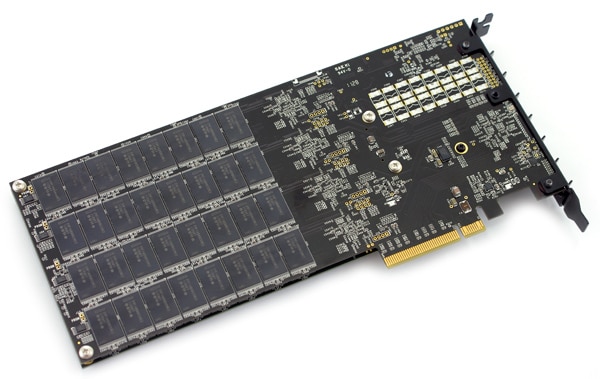
OCZ did a great job from a design perspective, keeping the parts within the boundaries of the card to minimize interference with other devices installed within the computer. Another feature (or lack of a feature) is the Z-Drive R4 sources all of its power from the PCIe slot itself, instead of requiring an external power source connected. This keeps additional parts and means of failure to a minimum and also shows that the R4 is fairly conservative when it comes to power usage. The Fusion-io drive we just reviewed requires a secondary power source for full performance.
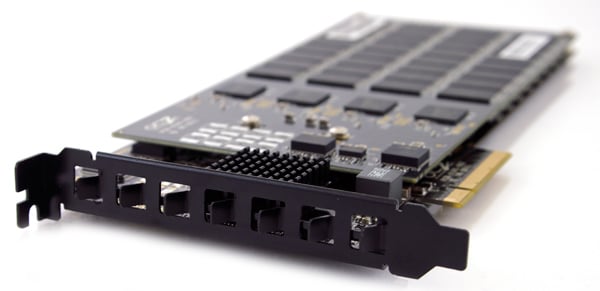
Cooling is completely passive on the Z-Drive R4, utilizing cooling air from the case itself, pushing air from the front of the card, over the NAND and controllers, and out the grill that is part of the PCIe mounting bracket. With the maximum power usage figure of 26w, the R4 is rated for just 90 LFM of air to stay within its operating temperature range under load.
Disassembly
The internals on the OCZ Z-Drive R4 are pretty much completely visible without needing to disassemble the drive itself. Given the high price of this item, we opted to leave the daughter board attached since the symmetrical parts layout meant that we could easily identify even partially obscured electronics on the board.
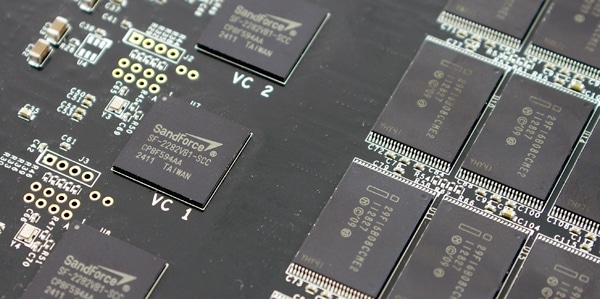
When it comes down to it, the R4 is pretty much eight SSDs mounted to the same circuit board. The 1.6TB user capacity of the R4 is comprised of 2,048GB of raw NAND, split up between 128 16GB Intel IMFT 25nm NAND pieces, with sixteen per SandForce SF-2282 processor.
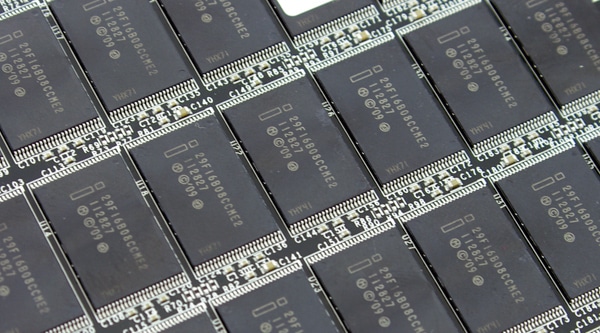
Synthetic Benchmarks
Given the higher performance capabilities of a PCIe SSD like the OCZ Z-Drive R4, we slightly modified our standard testing methods beyond how we stress-test single enterprise SSDs. To fully saturate the card we had to increase the I/O load through multiple managers and workers in IOMeter, otherwise we might not see the full potential of this drive. The method we came up with which allowed us to still work with the drive in an unformatted setup was to have two managers and two workers interfaced with the same 5GB LBA segment. This allowed us to fully saturate the Z-Drive R4 and reach speeds that the drive was advertised as being able to handle.
We split the synthetic IOMeter testing portion of this review into two parts. The first is our standard low queue-depth tests, which are performed at a QD=1 level on single drives and on PCI-e SSDs at a level of QD=4 given the manager/worker thread count. The initial tests are more in line with single-user environments, whereas higher queue depth ranges in the second half are more like what the card would see in a server setup with I/O requests stacked up.
OCZ is offering two versions of the Z-Drive R4; one full-height and one half-height. The main difference between both of these models, besides physical card height, is the number of SandForce SF-2200 processors. The full-height RM88 Z-Drive R4 has eight processors while its smaller RM84 half-height brother only has four. While a drop in performance is to be expected between these two models, it thankfully isn't on a linear scale. The RM88 peaks at 2,800MB/s sequential write and 410,000 IOPS random 4K write, while the RM84 drops off at 2,000MB/s and 250,000 IOPS. So while it has half the SandForce power under the hood, it only drops 28% in sequential write speed and 39% in random 4K write speed, thanks in large part to OCZ's SuperScale storage accelerator technology.
RM88 Max Performance Data
- Read: Up to 2,800MB/s
- Write: Up to 2,800MB/s
- Random 4k Write: 410,000 IOPS
- Max IOPS: 500,000
RM84 Max Performance
- Read: Up to 2,000MB/s (28% Lower than RM88)
- Write: Up to 2,000MB/s
- Random 4k Write: 250,000 IOPS (39% Lower than RM88)
- Max IOPS: 260,000
With advertised speeds of 2,800MB/s sequential read and write, the OCZ Z-Drive R4 nothing short of a NAND-filled powerhouse. Our previous fastest was the Fusion-io ioDrive Duo which topped out at 1,550MB/s read; meaning the Z-Drive R4 is almost twice as fast in sequential bandwidth. To see how well it performed in straight-line performance we used IOMeter with a 4K-aligned sequential 2MB transfer test, with an effective queue depth rate of 4.
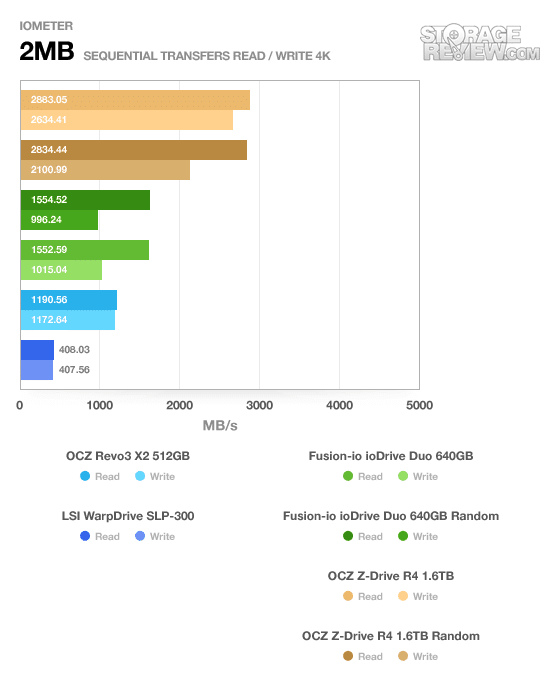
We measured a top speed of 2,883MB/s read and 2,634MB/s write on the R4, putting it well in the lead over the ioDrive Duo in both repeating and incompressible data tests. Read speed actually outperformed by 83MB/s, although write speeds came up short by 166MB/s.
Our next test looks at random large-block transfers, but still keeping the 2MB transfer size. Given the lack of internal moving parts on SSDs, these values don't change much beyond our sequential transfer test.
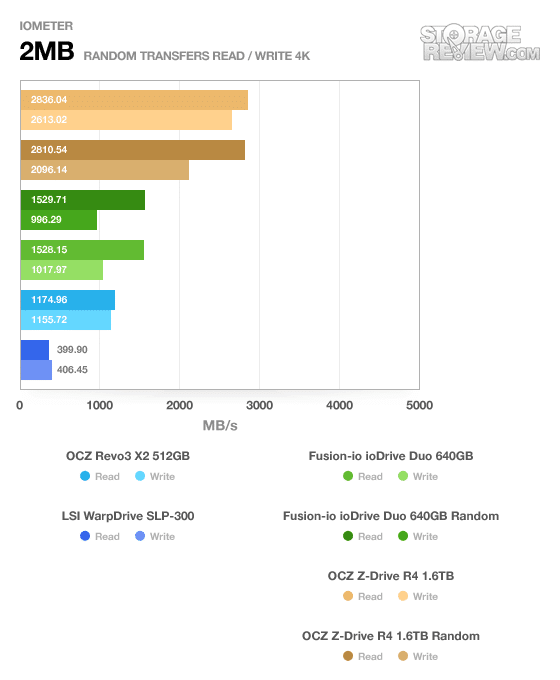
In the random 2MB transfer test the OCZ Z-Drive R4 still managed an impressive 2,836MB/s read and 2,613MB/s write over the ioDrive Duo's 1,528MB/s read and 1,017MB/s write.
Our next test looks at both low queue-depth 4K random read/write as well as peak queue-depth figures for all of the PCI-e SSDs we have tested in our lab.
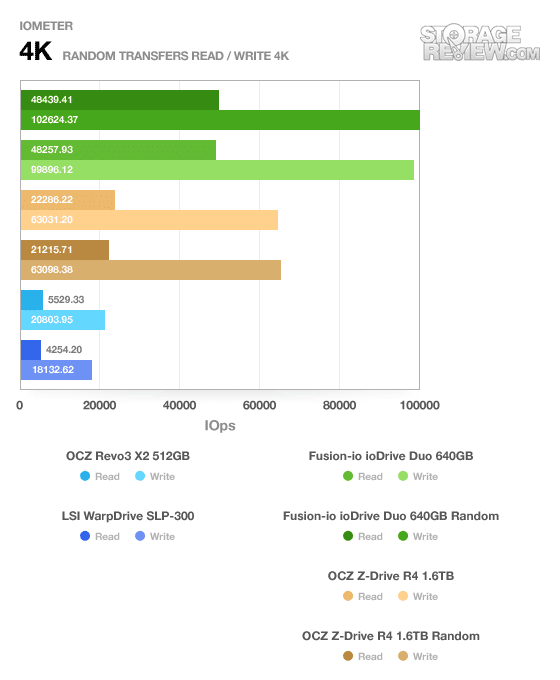
At a QD=4 starting point, the ioDrive Duo had a near 100% lead over the Z-Drive R4. don't be too quick to call out a leader yet though, since the Z-Drive R4 is only getting warmed up at this point. In the 4K MAX IOPS chart below, the R4 more than doubled the top performance of the ioDrive Duo with a peak speed of 308K IOPS read and 297K IOPS write versus just 116K IOPS read and 225K IOPS write.
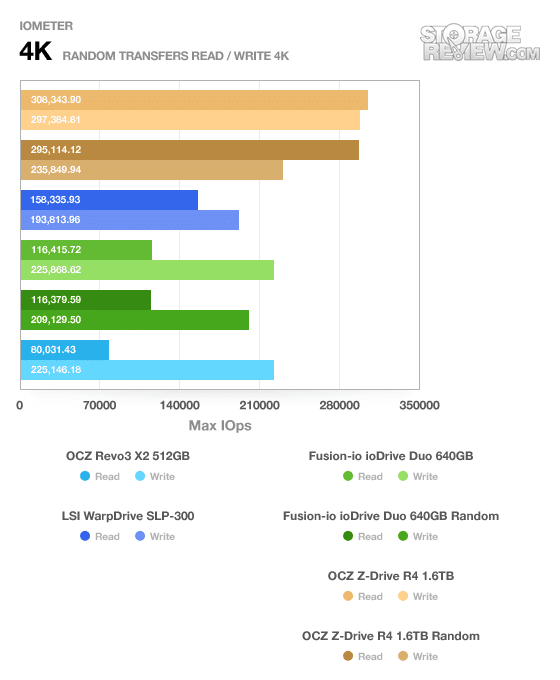
One interesting area to look at with the OCZ Z-Drive R4 is how fast its random 4K performance is at the peak QD=64 load (QD=265 with manager/worker spread). You might first ask yourself why it only topped out at 300k… well the answer is it was so fast it reached the upper limit of what the Intel Core i5-2300 processor in our Intel test rig could handle. With a single drive finally being able to push the limits of our test rig hardware, we now have plans in the works for a new enterprise-class rig for high-end equipment like the Z-Drive in future testing.
Given the strong QD=4 performance of the ioDrive Duo, it wasn't a surprise to see lower latency figures than the Z-Drive R4 in our chart. The differences in peak latency can probably be chalked up to NAND and controller differences, especially with the R4 having eight SandForce processors to sync together compared to just two controllers on the ioDrive Duo.
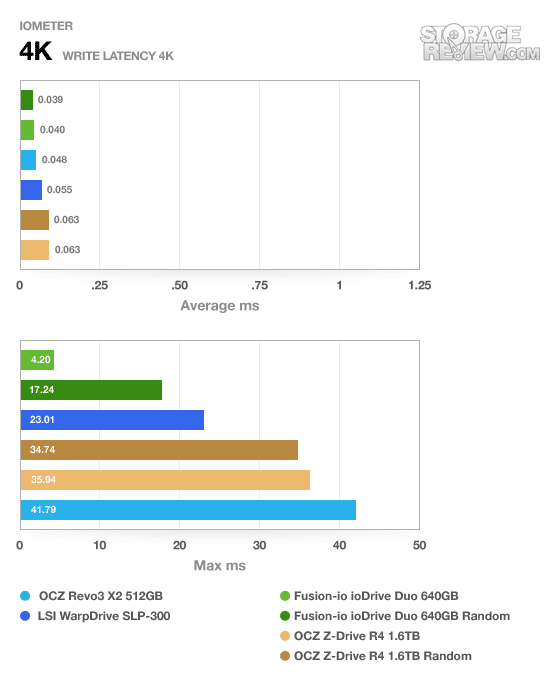
We also decided to show CrystalDiskMark results on each of these drives testing with randomized data. This type of benchmark is clearly not the optimal test to perform on an enterprise SSD that thrives in a multi-threaded environment, but it is still fun to use when comparing results to client drives.
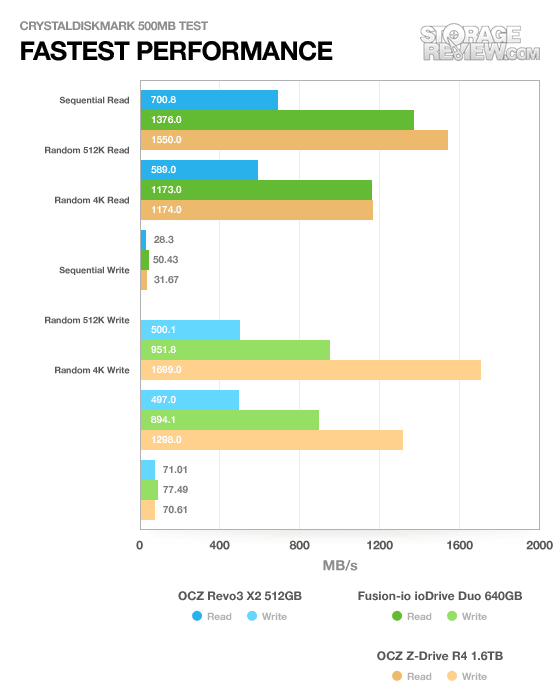
The next half of our synthetic benchmarks are ramped tests, covering performance from early queue depth levels to either a max of 64 (QD=256) or 128 (QD=512). This section also includes our server profile tests, which from the start are designed to show how well enterprise products perform under demanding mixed server loads.
The difference between the Z-Drive R4 and ioDrive Duo become very apparent in the expanded random 4K read and write test. At the lower queue depth ranges the Duo is above the R4, although the crossing point where the R4 comes out on top is at or during the switch from QD=2 to QD=4. After that point the R4 quickly ramps up to its top recorded speed.
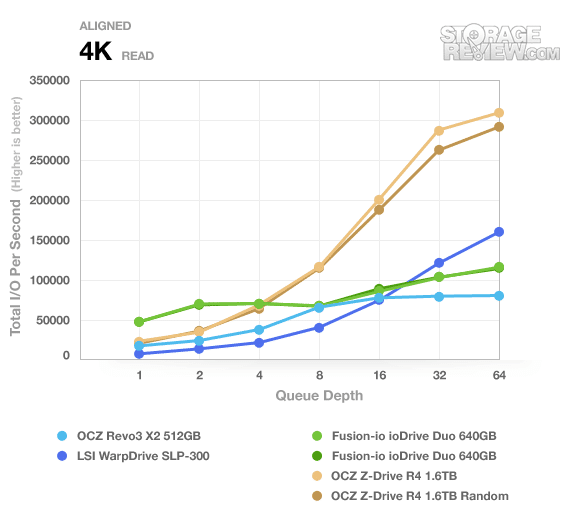
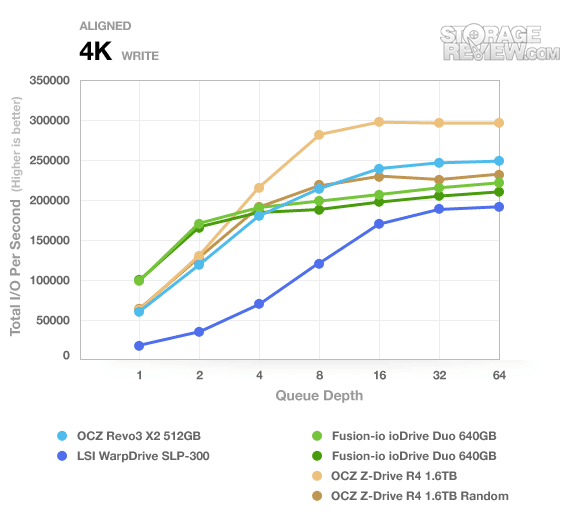
The next segment looks at our server profile tests, which unlike the random read/write 4K test, include mixed workload profiles. In each of these scenarios the Z-Drive R4 is so far above the ioDrive Duo and the older LSI WarpDrive SLP-300 that it almost doesn't appear that they are in the same league.
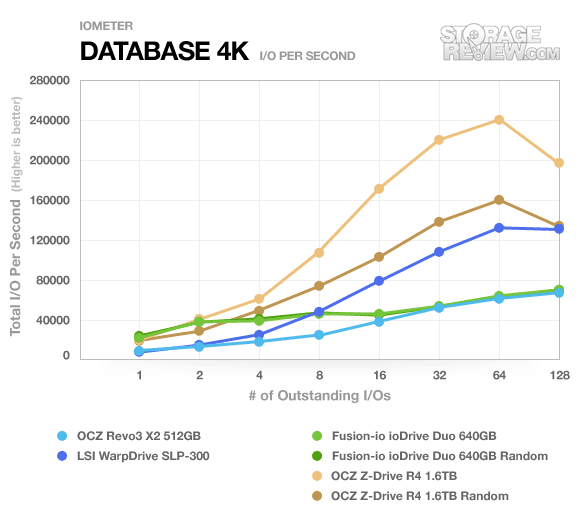
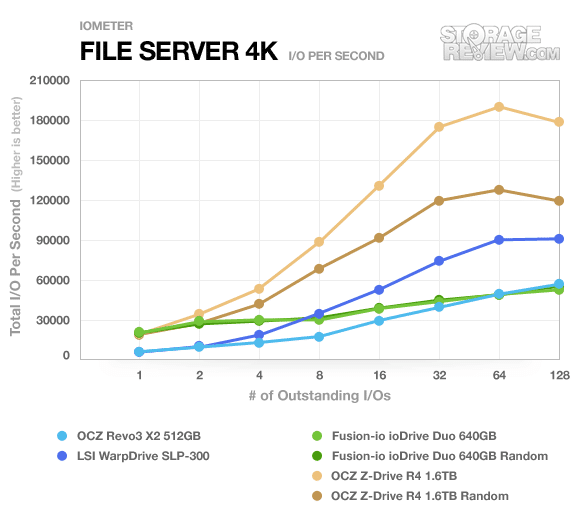
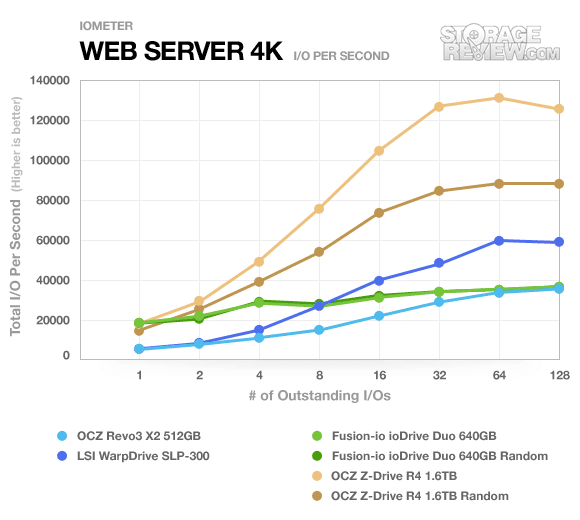
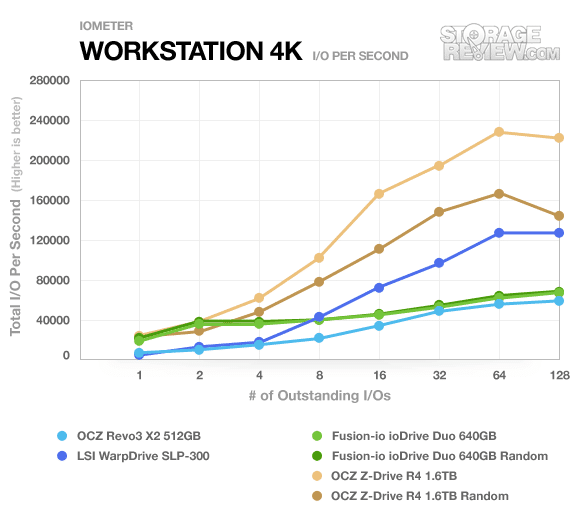
Real-World Benchmarks
If you are new to StorageReview, one thing we try to focus on is how any given drive might perform under real-world conditions. To really see how drives perform under normal work-loads you need to record the exact traffic being passed to and from the device, and then use that to compare drives against one another. For this reason we turned to our StorageMark 2010 traces, which include consumer traces covering HTPC, Productivity, and Gaming scenarios and now business traces starting off with a new mail-server scenario to help our readers find out how well a drive might perform under their conditions. We also have a new enterprise trace that we'll roll out after the client-focused tests.
We kept the same drives in the lineup for our real-world benchmarks, although with our mail-server trace being released after the LSI WarpDrive was reviewed, it was not included in that test.
The first real-life test is our HTPC scenario. In this test we include: playing one 720P HD movie in Media Player Classic, one 480P SD movie playing in VLC, three movies downloading simultaneously through iTunes, and one 1080i HDTV stream being recorded through Windows Media Center over a 15 minute period. Higher IOps and MB/s rates with lower latency times are preferred. In this trace we recorded 2,986MB being written to the drive and 1,924MB being read.
The OCZ Z-Drive R4 had no trouble staying in the lead in our HTPC trace. Measuring in with almost double the speed of the ioDrive Duo, the R4 scored an impressive 1,254MB/s average speed.
Our second real-life test covers disk activity in a productivity scenario. For all intents and purposes this test shows drive performance under normal daily activity for most users. This test includes: a three hour period operating in an office productivity environment with 32-bit Vista running Outlook 2007 connected to an Exchange server, web browsing using Chrome and IE8, editing files within Office 2007, viewing PDFs in Adobe Reader, and an hour of local music playback with two hours of additional online music via Pandora. In this trace we recorded 4,830MB being written to the drive and 2,758MB being read.
The R4 measured 854MB/s average in our productivity trace, having absolutely no trouble staying above the pack.
Our thirdclient-based real-life test covers disk activity in a gaming environment. Unlike the HTPC or Productivity trace, this one relies heavily on the read performance of a drive. To give a simple breakdown of read/write percentages, the HTPC test is 64% write, 36% read, the Productivity test is 59% write and 41% read, while the gaming trace is 6% write and 94% read. The test consists of a Windows 7 Ultimate 64-bit system pre-configured with Steam, with Grand Theft Auto 4, Left 4 Dead 2, and Mass Effect 2 already downloaded and installed. The trace captures the heavy read activity of each game loading from the start, as well as textures as the game progresses. In this trace we recorded 426MB being written to the drive and 7,235MB being read.
In our last client-based disk trace, the Z-Drive R4 again held a strong lead, measuring 1,184MB/s average with the striped ioDrive Duo coming in behind at 898MB/s.
Our first enterprise trace covers a Microsoft Exchange mail-server environment. We captured the activity of our StorageReview mail server over a period of a few days. This server hardware consists of a Dell PowerEdge 2970 running Windows Server 2003 R2 environment operating off of three 73GB 10k SAS hard drives in RAID5 on the Dell Perc 5/I integrated controller. The trace consists of many small transfer requests, with a strong 95% read load with 5% write traffic.
In our mail server trace, it appears that the advantage the OCZ Z-Drive R4 had in the initial trace playback scenarios changed, with the ioDrive Duo taking a strong lead in both single and striped configurations.
Conclusion
The OCZ Z-Drive R4 did nothing short of wow us the entire time we had it in our lab, as it literally performed so well that it broke our rig, forcing us to re-think the way we test enterprise PCIe solutions going forward. It blew away the competition in nearly every test by a significant margin, quite a feat considering the Z-Drive R4 costs 35-40% less than the Fusion-io ioDrive Duo. The Z-Drive R4 also bested the LSI enterprise PCIe solution, which has SandForce processors that are a generation old but still costs around four times as much per GB.
This is where OCZ really shows off their brilliance – the balance of performance and cost. OCZ has gone with less expensive MLC NAND and layered in the latest SandForce SF-2282 processors with software like SuperScale storage accelerator, which reduces CPU usage and power consumption, while still driving what really is, unmatched throughput.
As if OCZ needed more arrows in the quiver, the Z-Drive R4 is available in huge capacities, up to 3.2TB in the full-size card and 1.2TB in the half-height – which most other companies don't even offer. The drive is bootable as well, negating the need for an additional system drive and it doesn't require a secondary power source for full performance, like some other enterprise PCIe SSDs do.
Pros
- Incredibly fast, more than twice in some scenarios than the competition
- Priced very competitively at $7/GB
- No external power required
- Bootable
Cons
- Some slowdowns in non-4K optimized situations
Bottom Line
The OCZ Z-Drive R4 is simply amazing. The cost/performance ratio is off the charts, no other enterprise PCIe SSD can even hold a candle to the OCZ Z-Drive R4, when measured this way. OCZ has re-defined the art of blending hardware with software for a masterful enterprise SSD.


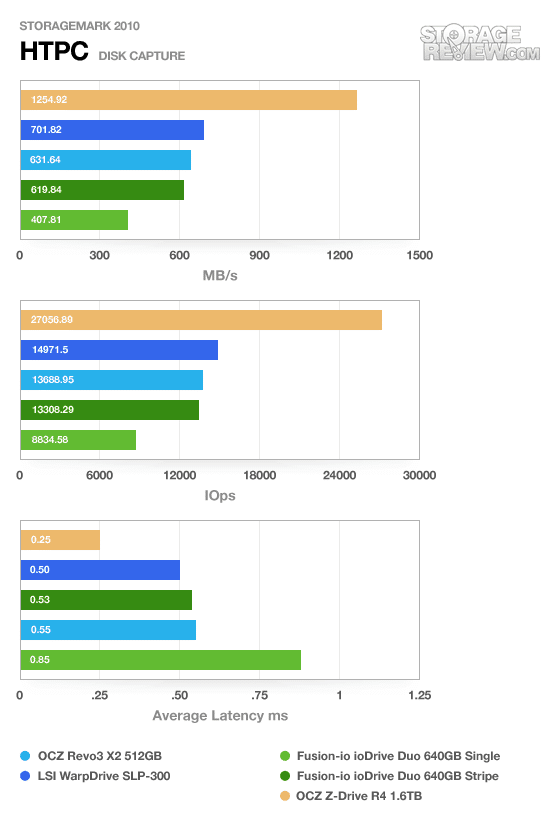
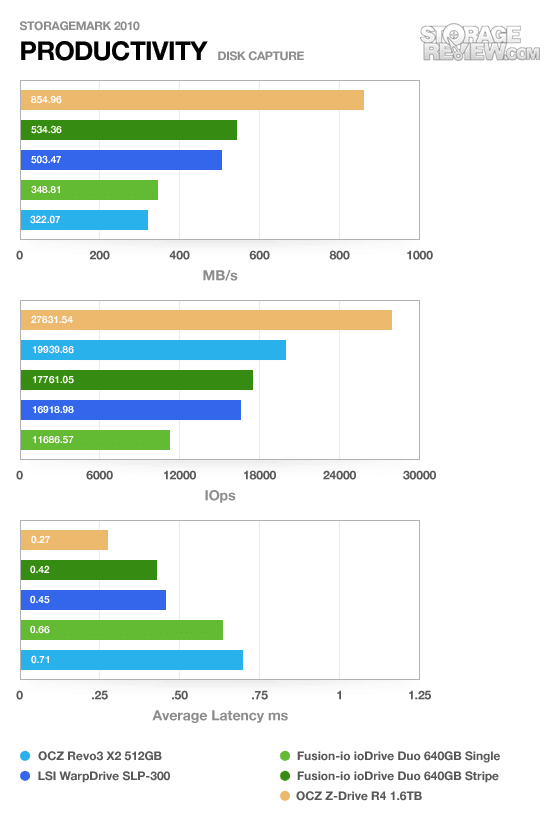
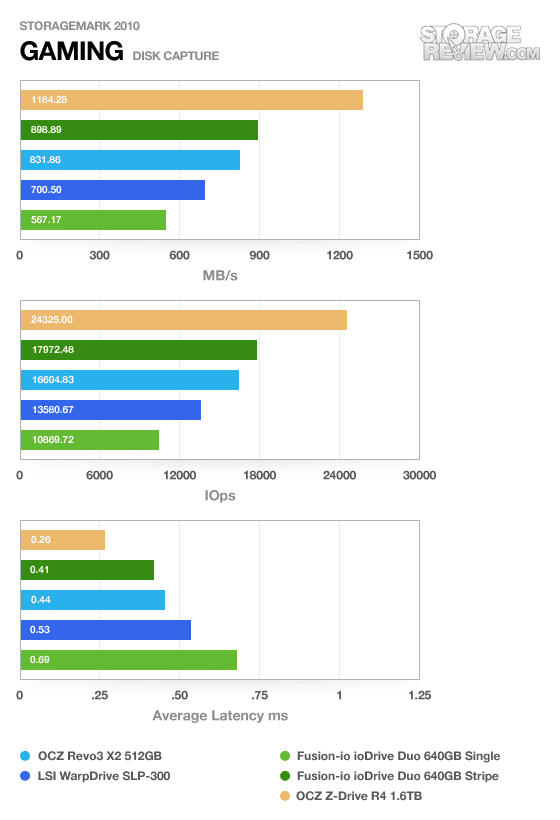
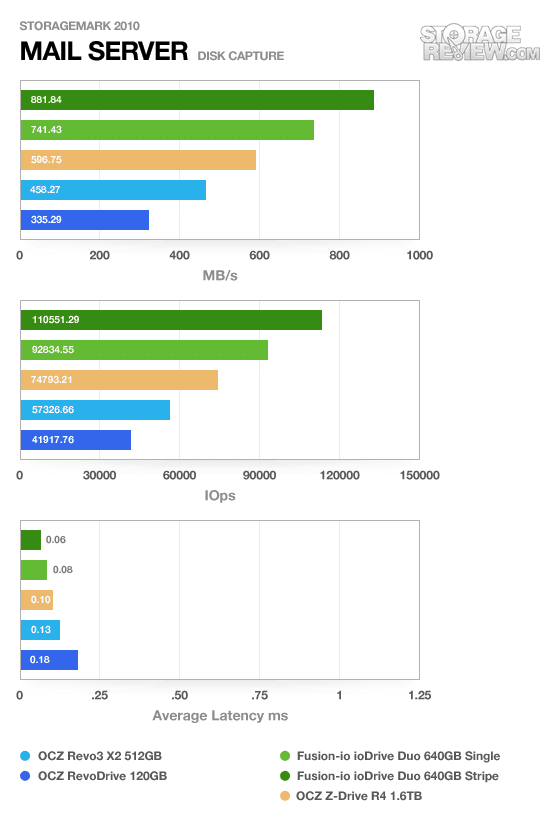


 Amazon
Amazon